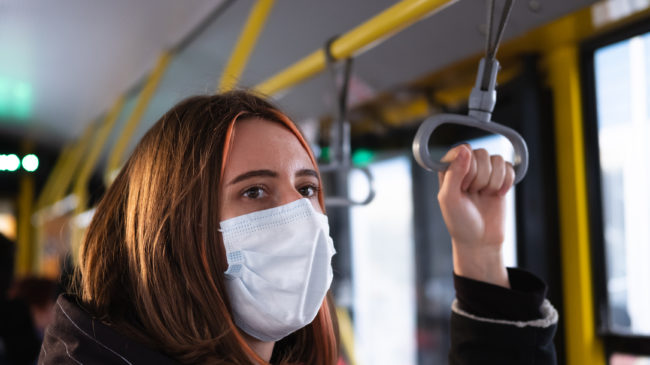The coronavirus pandemic has wreaked havoc on the economy, state and local budgets, and more, including mass transit agency operations. Mass transit ridership is down 80 percent and many agencies are not collecting fares, due in large part to stay-at-home orders in most urban areas.
Mass transit agencies have already received a $25 billion federal bailout and have asked for another $28.3 billion. House Democrats included $15.75 billion in the recently passed Health and Economic Recovery Omnibus Emergency Solutions (HEROES) Act, but the bill is unlikely to become law, according to Senate Republicans who oppose the bill and the White House, which has issued a veto threat.
But don’t mistake President Trump’s veto threat for lack of support for transit subsidies. The president has been eagerly tweeting announcements about the mass transit spending in the previous $2.3 trillion bipartisan stimulus bill.
In normal circumstances, mass transit agencies could turn to state governments for additional funding, but states have their own massive budget holes due to declining income and sales tax projections. Since states are required to balance their budgets, they are unlikely to have any extra funding for transit operations and projects in the short-term, so transit agencies are likely going to have to cope with existing funds unless there’s an additional stimulus bill.
The lack of revenue coming into mass transit systems is going to continue to be connected to the biggest challenge right now—keeping riders and employees safe during the pandemic. Determining whether, or how much, New York City subway systems played a role in spreading COVID-19 has been controversial. A non-peer reviewed study by Massachusetts Institute of Technology (MIT) Economist Jeffrey Harris argued that several New York City subway lines were a major disseminator if not the principal transmission vehicle of the disease in the first two weeks of March 2020. Moreover, the decline in subway use helped reduce virus spread, he claimed. The MIT author acknowledges that this type of study (observational) has disadvantages and its methodology was heavily criticized by CityLab and the Mercatus Center, whose policy analyst Salim Furth wrote that “the only clear claim in Harris’ paper is the title: ‘The Subways Seeded the Massive Coronavirus Epidemic in New York City.’ The data analysis presented in this study provides far more evidence against that title than Harris musters in its favor.”
Nevertheless, public officials, from New York City, the Washington Metropolitan Area Transit Authority, and numerous other cities and countries have advised commuters to avoid mass transit if at all possible.
Mass transit ridership levels are likely to continue to be lower than normal until a vaccine or effective therapy is widely available, which may not be until next spring or later. In the meantime, transit agencies should focus on prioritizing service for the riders who must ride the systems, making safety improvements, and reducing costs.
Typically, transit-choice riders own cars and/or they have jobs that allow them to work from home. Transit-dependent riders are typically lower-income workers who don’t own cars and must report to work at a physical location. Thus, they are more likely to continue using transit. As a result, transit agencies need to redesign service for transit-dependent riders. Many transit agencies claim to care about transit-dependent customers, who mostly use buses in cities outside of New York, even as they build costly new light-rail lines aimed to attract transit-choice riders. The economic downturn should prompt transit agencies to focus on the customers who need transit the most.
To increase safety, transit agencies can take advantage of lower ridership and reduce rail service. To limit the spread of COVID-19, transit vehicles need to be sanitized multiple times a day. Existing trains should be run with extra cars (8-10 total) to encourage social distancing. But outside of New York City, Washington, DC, and the core areas of the Boston, Chicago, Philadelphia, and San Francisco regions, transit agencies should review ridership needs and consider discontinuing underused but costly rail service until the threat of COVID-19 recedes.
To replace rail lines, transit agencies could move their buses from low-density to high-density suburbs. Buses offer sufficient capacity for the current demand. In addition, headways, the amount of time between buses on a route, can be adjusted if travel patterns change.
To replace bus service in low-density areas, agencies can examine partnering with ridesharing services such as Uber and Lyft. Agencies may need to provide vouchers to low-income customers and transit operators can use tax records to validate income.
Many transit agencies have suspended fare collection efforts. However, fares typically cover 20-40 percent of US transit system costs so most agencies cannot eliminate fare collection indefinitely. And economists have shown that people place a higher value on a service that they pay for. Free transit service is considered inferior. As local economies reopen, transit services should resume collecting fares.
Thankfully, there are ways to collect revenue without endangering workers or customers. Many agencies including the Chicago Transit Agency (CTA) have added fare card readers at back doors. Another option would be to add credit card readers and allow riders to pay with credit cards. For front-door boarding, agencies could add plexiglass barriers to the right of drivers to prevent passengers from sneezing, coughing, or breathing on drivers.
Additionally, mass transit agencies and unions may need to discuss reworking contracts. Train operators and mechanics might need to be retrained for buses. They could keep the same pay and benefits, but union contracts that specify the type of vehicles would need to be changed. Split-shifts could be eliminated, but this might reduce hours worked. Labor represents about 70 percent of the costs for most American transit agencies and with a prolonged period of ridership decline, those costs are not sustainable.
Transit ridership had been declining for several years before coronavirus, and now the pandemic promises to challenge these systems for months to come, if not permanently. Transit agencies may need to make innovative changes to survive.

